Blogs

Port Isolation to the Rescue at the Edge
Tue, 26 Sep 2023 08:33:28 -0000
|Read Time: 0 minutes
IT to Operation Technology (OT) convergence is in full swing in many vertical markets and understanding the differences in each expertise from the personas who make purchasing and architectural decisions is crucial when enterprises are planning their IT and OT investments.
Many IT professionals practice port isolation in networking, which is considered a critical skill and is a well-known way of protecting applications, virtual machines, and containers and providing secure separation. Common practices include DMZs, VLANs, layer 7, or traditional firewalls. Virtualization can bring an additional layer of memory protection in these cases.
IT network port isolation is all around the isolation of networked resources. In researching port isolation, most of the results will solely focus on the IT administrators trying to isolate these ports in their network environment. Addressing applications over TCP or IP ports and implementing port isolation to protect them from network attacks, spoofing, or other methods are good practices for defending against these threats.
In OT and industrial control systems (ICS), port isolation is a crucially different task and is classified as electrical overstress (EOS) protection.
In edge and industrial environments, it is expected that devices will run continuously regardless of the interference they encounter. Therefore, ensuring resilience against electric static discharge (ESD), electric fast transients (EFT), and Lightning strikes (Surges) is crucial. Achieving good electromagnetic compatibility (EMC) for these systems can be challenging.
Port isolation is a way to protect devices from environmental electrostatic interferences in serial, industrial networking, or CAN. Many Edge devices are exposed to greater interferences due to their deployment in locations that do not provide exhaustive protection. Metal cabinets give Ingress Protection (IP) which is an international standard (IEC 60529) for the degree of protection and resistance to dust and moisture. IP protection does not protect against the EOS. The wires that communicate with the engines, sensors, conveyor belts, and pumps are often outside and fully exposed to the surroundings. These wires are all routed into the same compute endpoint and the length of these wires amplifies the exposure to EMC interference.
Helping customers that have experienced incidents that had catastrophic failures, and, sometimes, even epidemic failures can be time-consuming and costly. Often these happen not because of the lack of quality of the devices, but mainly using them outside of the validated and appropriate work areas. Special attention is needed during the purchase, architecture, and assembly of hardware components before they are rolled out into Edge environments.
Electrical components that are inside these Edge devices are vulnerable to these failures; CMOS ICs (chips), and integrated circuits built with MOSFETs. Examples: computer CPUs, graphics ICs, and computer cards.
ESD
Many people have experienced static electricity or "shocks" called electrostatic discharge (ESD) when touching a metal after walking across a carpeted floor or getting from a turning office chair and then shaking someone’s hand. However, static electricity and ESD have created serious industrial problems for centuries. In the early 15th century military forts were using grounding devices to prevent ESD —Electrostatic discharge is known for causing damage to sensitive electronics. This damage can occur in several different ways depending on the potency of the ESD and the type of electronics you are working with.
- Shorting—ESD can cause shorting by connecting two parts of a circuit that shouldn’t be connected. This will usually only occur if the electronics are powered up when the ESD hits them, and it may not cause permanent damage.
- Over-powered components—Many small electrical components have specific power ratings. Potentially coming in at thousands of volts, ESD can over-power the components inside your electronics and damage them from the inside out.
- Heat damage—ESD can create a significant amount of heat rapidly, and this has the potential to cause physical damage to the components inside your electronics.
EOS damage
EOS damage can be degrading over time and components that have been exposed to EOS damage can work for some time in the field. Over time when components age and get damaged they will come to a point where they cannot do their work anymore.
The following figures show almost unnoticeable damage for the naked eye, but it will result in component failure over time.
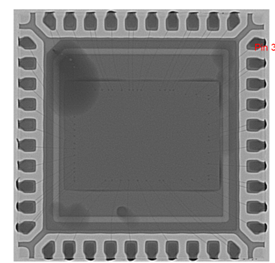

EFT
Cables near motors can pick up high-voltage and high-frequency electrical fast transients (EFTs). The longer the cables the bigger of an antenna they form, making it easier for electronics to pick this up, and this can have the same effect on electronics and damage them. If these communication lines such as RS-485 use a different signal, they still can be vulnerable to these transients.
The following figures are examples of components being exposed to EFT and visible in this case. Both serial ports in this example have been exposed to high voltages resulting in even the tops of the components being blown away.

Surge
Things like lightning can cause serious damage to equipment. When lightning strikes, the energy can expose equipment to high energy, especially if the devices are in areas that are vulnerable to these incidents, without protection. For example, telco base stations could be due to the height of the poles being vulnerable to these exposures.
The following figure shows that the transformer has not been sufficient to protect against the surge that was exposed to this Ethernet port.
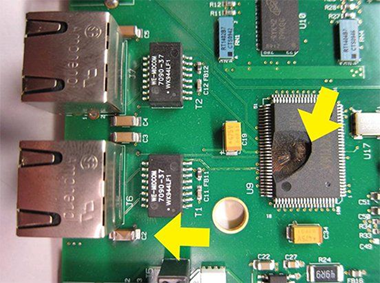
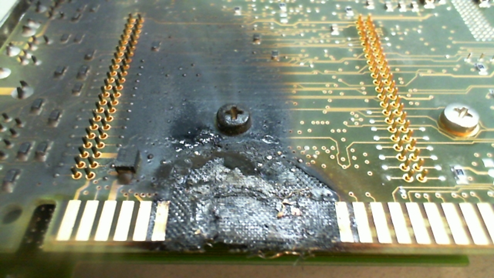 This effect can be increased if the location of the sensors and the computing equipment are in locations with different ground potentials. During a lightning strike, one location can be charged differently causing heavy current flow through the serial lines, which can cause surges.
This effect can be increased if the location of the sensors and the computing equipment are in locations with different ground potentials. During a lightning strike, one location can be charged differently causing heavy current flow through the serial lines, which can cause surges.

Severity
Equipment has been validated to withstand a significant amount of EOS, especially our industrialized products which are designed to meet these rugged environments, but the amount of degradation that will occur in these industrial environments can vary, and the following figure indicates a scope of what can be expected in the environments. The following figure explains EOS severity; and surge voltage against the duration of EOS.
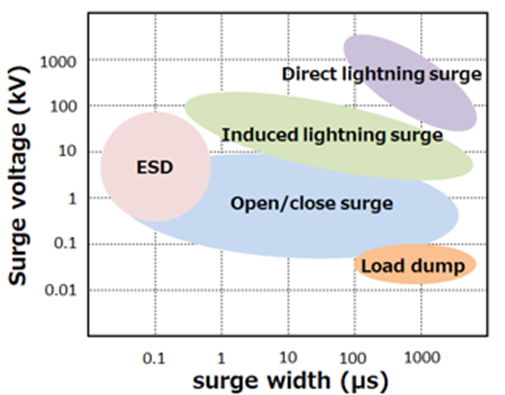
Preventive measures against ESD
The environment where the devices are being handled can be a cause of failure and requires different measures to prevent devices from being introduced to ESD. Safe working environments typically have ESD safe flooring and ESD safe workbenches where strap bands are used to handle sensitive equipment.
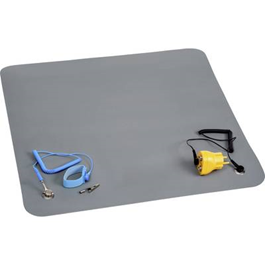
Hipot testing
High Potential (Hipot) testing or insulation resistance testing method that assures sufficient dielectric withstand is used to determine whether the ground wall can handle an over-voltage situation. An over-voltage situation is a voltage higher than the peak operating voltage of a device under test.
Preventive measures against EOS in Dell Edge Gateways
By introducing isolation components into the design and replacing traditional serial, CAN, or network ports with isolated options, the potential damage caused by surges can be reduced. Designs against the different threats can significantly reduce the damage caused to the devices and assure device uptime.
To reduce the risk and exposure to EOS, the Dell Edge Gateway 5200 and Dell Edge Gateway 3200 can be equipped with special addon. The two gateways can be purchased to introduce isolation protection. This will replace the non-isolated legacy ports and introduce protection towards endpoints that have potentially greater exposure to EOS.
SKU | SKU external description | Isolation protection |
492-BDFK | EGW-3200 isolated Canbus (EMUC-B202) | Complies with EN61000-4-5 2.5 kV Surge protection. Complies with IEC 60950-1:2005 + A1: 2009 + A2:2013 2.5kV HiPOT protection. Complies with EN61000-4-2 (ESD) Air-15 kV, Contact-8 kV. |
555-BIDQ + 492-BDFX | EGW-3200 isolated PoE Out Module (EMPL-G2P1) + EGW32/52 60 W AC Adapter (excluding power cord) | Complies with EN61000-4-2 (ESD) Air-15 kV, Contact- 8 kV. |
492-BDHQ | EGW-3200 isolated RS-422 & RS-485 Module (EMP2-X4S2) | Supports port-to-computer isolation, complies with IEC 60950-1:2005 + A1: 2009 + A2:2013 2.5 kV HiPOT protection. Complies with EN61000-4-2 (ESD) Air-15 kV, Contact-8 kV. |
492-BDHR | EGW-3200 isolated RS-232 Module (EMP2-X2S1) | Support port-to-computer isolation. Complies with IEC 60950-1:2005 + A1: 2009 + A2:2013 2.5 kV HiPOT protection. Complies with EN61000-4-2 (ESD) Air-15 kV, Contact-8 kV. |
492-BDFM | EGW-3200 isolated Gigabit Ethernet (EMPL-G201) | Complies with EN61000-4-5 1kV Surge protection. Complies with IEC 60950-1:2005 + A1: 2009 + A2:2013 2 kV HiPOT protection. Complies with EN61000-4-2 (ESD) Air-15kV, Contact-8 kV. |
SKU | SKU external description | Isolation protection |
492-BDGW | EGW-5200 isolated Canbus (EMUC-B202) | Complies with EN61000-4-5 2.5 kV Surge protection. Complies with IEC 60950-1:2005 + A1: 2009 + A2:2013 2.5 kV HiPOT protection. Complies with EN61000-4-2 (ESD) Air-15 kV, Contact-8 kV. |
492-BDFN+ 492-BDFX | EGW-5200 isolated PoE Out module (EMPL-G2P1) + EGW32/52 60 W AC adapter (excluding power cord) | Complies with EN61000-4-2 (ESD) Air-15 kV, Contact- 8 kV. |
492-BDGU | EGW5200 isolated RS-422 & RS-485 module (EMP2-X4S2) | Supports port-to-computer isolation, complies with IEC 60950-1:2005 + A1: 2009 + A2:2013 2.5 kV HiPOT protection. Complies with EN61000-4-2 (ESD) Air-15 kV, Contact-8 kV. |
492-BDFL | EGW-5200 isolated RS-232 module (EMP2-X2S1) | Support port-to-computer isolation. Complies with IEC 60950-1:2005 + A1: 2009 + A2:2013 2.5 kV HiPOT protection. Complies with EN61000-4-2 (ESD) Air-15 kV, Contact-8 kV. |
492-BDGX | EGW-5200 isolated Gigabit Ethernet (EMPL-G201) | Complies with EN61000-4-5-1 kV Surge protection. Complies with IEC 60950-1:2005 + A1: 2009 + A2:2013 2kV HiPOT protection. Complies with EN61000-4-2 (ESD) Air-15 kV, Contact-8 kV. |
492-BDFW | EGW-5200 isolated DIO |
|
 About the Author: Jeroen Mackenbach
About the Author: Jeroen Mackenbach
Jeroen Mackenbach is a Technical Staff – Engineering Technologist for Edge in the Infrastructure Solutions Group. He is a trusted advisor for engineering, leadership, and global customers bringing edge solutions to the market and complementing sales teams with essential technical insights. Jeroen draws on more than 25 years of expertise in embedded systems hardware and software, as well as the Linux ecosystem, helping customers address the challenges associated with edge and distributed environments. Jeroen joined Dell Technologies in 2018 and was invited to become a CTO ambassador. Jeroen is a regular speaker at Executive Briefings and industry events, including the Embedded Linux Conference in 2018 and 2019. Before joining Dell Technologies, Jeroen spent more than 20 years in Production Management and Technical Sales roles for design and manufacturing services. He speaks English and Dutch and holds technical qualifications in Electronics and Communications Engineering from the Hogeschool Rens en Rens in Hilversum, Netherlands.

How Dell PowerEdge XE9680 Accelerates AI and High Performance Computing
Tue, 11 Apr 2023 21:37:45 -0000
|Read Time: 0 minutes
The Dell PowerEdge XE9680 is a high-performance server designed to deliver exceptional performance for machine learning workloads, AI inferencing, and high-performance computing. In this short blog, we summarize three articles that showcase the capabilities of the Dell PowerEdge XE9680 in different computing scenarios.

Unlocking Machine Learning with Dell PowerEdge XE9680
The first article, which I co-wrote with Liz Raymond, Naye Yoni, and Frank Han, describes how Dell PowerEdge XE9680 can unlock machine learning performance by delivering high-speed processing and efficient training of machine learning models. Based on our testing, we concluded that Dell PowerEdge XE9680 can help organizations unlock the full potential of their machine learning workloads:
Unlocking Machine Learning with Dell PowerEdge XE9680: Insights into MLPerf 2.1 Training Performance
Accelerating AI Inferencing with Dell PowerEdge XE9680
The second article, also co-written with Liz Raymond, Naye Yoni, and Frank Han, focuses on how the Dell PowerEdge XE9680 can accelerate AI inferencing using various models to make predictions or decisions. Our testing found that the Dell PowerEdge XE9680 can help organizations achieve faster and more accurate AI inferencing:
Accelerating AI Inferencing with Dell PowerEdge XE9680: A Performance Analysis
Accelerating High Performance Computing with Dell PowerEdge XE9680
The third article, co-written with Frank Han, showcases how Dell PowerEdge XE9680 can accelerate high-performance computing (HPC) by leveraging parallel processing techniques to solve complex problems. It focuses on the system's impressive performance in the HPL benchmark, which measures HPC performance. We concluded that the Dell PowerEdge XE9680 can help organizations achieve faster and more efficient HPC performance, enabling them to solve complex problems in less time:
Accelerating High-Performance Computing with Dell PowerEdge XE9680: A Look at HPL Performance
Author: Delmar Hernandez, Server Technologist

XR4000: Don’t be Afraid of the Edge!
Tue, 06 Dec 2022 23:18:48 -0000
|Read Time: 0 minutes

Halloween is just around the corner, and we have been seeing all sorts of innovative decorations around our neighborhood. The malls and shops are filled with cool gadgets to get the best scare out of you. Well, everything is getting an upgrade with technology, so why not Halloween? Are you trying to set up the haunted house you always wanted? AR apps are a must-try for that! Need a dancing skeleton, friendly ghost Casper, or maybe just the fanciest costume for your dog? Everything is possible with the help of an edge computing solution. Bringing the processing and computing of a data center to the edge and reducing latency to a minimum enables myriad use cases for retail and manufacturing.

Dell Technologies’ latest PowerEdge server, Dell PowerEdge XR4000, powered by Intel Xeon-D HCC 2700 SoC, comes in a unique sled and chassis form factor. One of the best values of this server is the short depth of just 355 mm (with bezel) (see PowerEdge XR4000—Small But Mighty), which enables you to put this server in a shoebox or mount it on a closet wall and forget about it. The sled comes in 1U and 2U form factors, which enables various deployment options depending on the edge workload. It is purpose-built for rugged conditions and can operate in a temperature range of –5°C to 55°C. So whether you are in Texas or California, XR4000 will continue to perform reliably. No need to worry about dust storms, tornadoes, or hail because this edge server has industry-standard certification for NEBS and MIL-STD.
PowerEdge XR4000 is powered by Intel Xeon D (Ice Lake D), making it Dell’s first Xeon D-based server. This ”made-for-the-edge” CPU comes with up to 20 cores with support of extended temperatures. It is up to 2.97x faster than its previous generation Skylake-D. The AI inferencing (CPU) gains have been improved by up to 7.4x. Ethernet connectivity is up by 400%, by providing networking up to 100 GbE and a variety of port options, with up to eight ports at 25, 10, or 1 Gbps with RDMA (iWARP and RoCEv2). Ethernet processing throughput is up by 150%, with 50 Gbps and 100 Gbps throughput options.

Support for NVIDIA A2 and A30 GPUs also enables smooth operation for AI/ML workloads. We ran industry-standard MLPerf 2.0 for ssd-resnet34 (object detection, large) workload testing on XR4000 with 1 x A2 GPU and concluded that it has 11% lower latency (in milliseconds) than a 1 x A2 GPU configuration of Supermicro SYS-220HE for multi-stream scenario.[1a] This means that XR4000 can analyze frames from multiple cameras simultaneously 11% faster than Supermicro.[1b] So, Halloween need not be limited to just the scary gadgets; we can also ensure the security in our neighborhood by real-time tracking of our streets and live video streams, making sure that no suspicious activity is taking place around the block. XR4000 also has 12% more throughput (in samples/second) than Supermicro SYS-220HE in ssd-resnet34 (object detection, small) offline scenario [2a] (one of the most used real-life scenarios). This means if you don’t have a constant flow of data, and instead have it all in the memory, XR4000 can identify the people and locations in a photo album much faster.[2b] The offline scenario represents batch-processing applications where all data is immediately available and latency is unconstrained.
One of my favorite Halloween characters is Hermione, so how can we leave a Harry Potter-themed party out of the picture? The “Sorting Hat” is the magical AI that can recognize and assign the Hogwarts house, but with the XR4000 using BERT NLP, we can truly offer real-life AI that delivers better outcomes and lower latency. If you want to test your knowledge of Harry Potter trivia, use AI’s help to get the right answers immediately. The secret sauce here would be using a natural language processing (NLP) tool called BERT (Bidirectional Encoder Representations from Transformers). Before BERT, NLP was unidirectional, which means the algorithm could only understand text read in one direction. BERT understands text in both directions, so it’s easy for it to get full context with just a word. We ran a similar workload on XR4000 using MLPerf 2.0 called bert-99 (Lang Processing) with an A2 GPU. It resulted in 11% lower latency than the Supermicro SYS-220HE (lower is better). [3a,b]

So far, Halloween is looking great with XR4000, but that’s not it. We can add more features pertaining to the safety of the kids. For example, parents can choose to witness their children during trick or treating without getting in the way of the fun—in the same way XR4000 with its optional Nano server sled can provide an in-chassis witness node for a vSAN cluster. Replacing the need for a virtual witness node, the Nano server can function as an in-chassis witness node, allowing for a native, self-contained 2-node vSAN cluster in even the 14” x 12” stackable server chassis. This allows for VM deployments where the option was previously out of the question due to latency or bandwidth constraints, and, ultimately, we can just come up with a virtual trick-or-treat app! A single-socket Dell PowerEdge XR4000 server equipped with the Intel Xeon D-2776NT has a VMmark Power Performance score of 3.64 @ 4 Tiles.[4] This is representative of different virtualization workloads that can run optimally maintaining the constraints of latency important for the edge with a strong level of performance while keeping power measurement in check, making it an excellent choice for edge customers who want to take advantage of the benefits that virtualization has to offer.

All these use cases are in the category of edge computing. Compute and storage resources are placed closer to where data is collected, processed, and consumed, eliminating the backhaul latency that occurs when sending/receiving data from a traditional data center. On top of all this, system management provides options so you don’t need to worry about maintenance issues or missing a data point or trends because at the heart of PowerEdge XR4000 is the integrated Dell Remote Access Controller 9 (iDRAC9). It is embedded in the server to streamline the process of deployment, update, service, and troubleshooting—all remotely or from your cellphone app.
It’s safe to say that the edge does not scare us anymore! PowerEdge XR4000 is a unique short-depth edge server that helps with low power and low footprint, and ultimately lowers TCO.
To learn more about the PowerEdge XR4000, see PowerEdge XR Rugged Servers.
Reference
[1a] Unverified MLPerf v2.0 Inference ssd-resnet34 (object detection, large), multistream. Result not verified by MLCommons Association. MLPerf name and logo are trademarks of MLCommons Association in the United States and other countries. All rights reserved. Unauthorized use strictly prohibited. See www.mlcommons.org for more information.
[1b] Based on testing conducted in Dell Cloud and Emerging Technology lab. For a multistream video, XR4000 has 11% less latency than Supermicro SYS-220HE for object detection (large workload).
[2a] Unverified MLPerf v2.0 Inference ssd-resnet34 (object detection, small), offline. Result not verified by MLCommons Association. MLPerf name and logo are trademarks of MLCommons Association in the United States and other countries. All rights reserved. Unauthorized use strictly prohibited. See www.mlcommons.org for more information.
[2b] Based on testing conducted in Dell Cloud and Emerging Technology lab, For an offline scenario, XR4000 has 12% more throughput than Supermicro SYS-220HE for object detection (small workload).
[3a] Unverified MLPerf v2.0 Inference bert-99 (Lang Processing). Result not verified by MLCommons Association. MLPerf name and logo are trademarks of MLCommons Association in the United States and other countries. All rights reserved. Unauthorized use strictly prohibited. See www.mlcommons.org for more information.
[3b] Based on testing conducted in Dell Cloud and Emerging Technology lab, For a single-stream video, XR4000 has 11% lower latency than Supermicro SYS-220HE for language processing task.
[4] Based on the performance testing conducted in Dell Solution Performance Analysis (SPA) lab on 9/30/2022.

